Step into a dimly lit jazz club, and you’ll hear it—the warm, round voice of a hollowbody archtop, the crisp bite of a Telecaster played with just the right touch, the unmistakable dialogue between wood, strings and amplifier. Jazz is about tone, but it’s also about touch. Every great jazz guitarist—Wes Montgomery with his thumb, George Benson with his effortless fluidity, Ted Greene with his cathedral-like harmonies—found a guitar that wasn’t just an instrument, but a partner in improvisation.
Jazz is the art of being completely in the moment—mindful and mindless all at once. The right guitar doesn’t just play notes; it breathes with you. That's why finding the right jazz guitar is like finding your voice. For some, it’s a full-bodied archtop with a floating pickup and the resonance of a grand piano. For others, it’s a semi-hollow with a little more grit, a little more bite—enough to punch through the band without losing warmth. And for the adventurous, it might just be playing a solidbody guitar—transcending convention like Julian Lage or Mary Halvorson.
To help you decide on the right guitar, in this article, we’ll explore what makes a guitar great for jazz, then profile 10 models that embody what guitarists look for in their musical companion. Whether you’re laying back in a chord-melody ballad or pushing the edges of harmony, let us help you swing with the best of them.

Pictured: D'Angelico Excel EXL-1 and Yamaha SA2200 Headstocks
Table of Contents
What Makes a Great Jazz Guitar?
Comparing the Best Electric Guitars for Jazz
The Top 10 Electric Guitars for Jazz
D'Angelico Excel EXL-1
D'Angelico Premier SS
Epiphone 150th Anniversary Zephyr DeLuxe Regent
Epiphone Broadway
Epiphone Casino
Fender Player II Telecaster
Gibson ES-335 '60s Block Limited Edition
Gibson ES-330
Ibanez LGB30 George Benson Signature
Yamaha SA2200
Back to the Head
People Also Ask ...
What Makes a Great Jazz Guitar?
From the first time an unknown, possibly apocryphal guitarist reportedly taped a phonograph needle to the top of the archtop as a sort of primitive contact mic, to modern active pickups, jazz guitarists have been on a relentless quest to be heard—not just as a rhythm machine behind the horns, but as a solo voice. Early pioneers like Charlie Christian proved that a properly amplified guitar could hold its own against brass and reeds, setting the stage for the golden age of jazz archtops.
Over time, the palette expanded—full-hollowbody guitars gave way to semi-hollows, then to solidbodies in the hands of players willing to bend tradition. The common thread? A great jazz guitar needs to be expressive, dynamic and as responsive as the player who picks it up.

Pictured: D'Angelico Excel EXL-1 F-hole and Bridge
Like jazz itself, a great jazz guitar combines many different elements into a cohesive whole. What are the main factors that make a guitar great for jazz?
- Warm, articulate tone: A great jazz guitar balances clarity and warmth, ensuring complex chords ring out with definition while single-note lines stay rich and full.
- Touch sensitivity: Jazz players rely on dynamics, so a guitar should respond well to variations in attack, allowing for expressive phrasing.
- Sustain and resonance: Whether it’s a big-bodied hollowbody with a floating pickup or a semi-hollow with a center block, a jazz guitar should have a natural sustain that enhances melodic phrasing.
- Comfortable playability: Many jazz guitars feature slightly wider necks, flatter fretboards and smooth frets for effortless chord voicings and intricate single-note runs.
- The right pickups: Traditional jazz tones favor lower-output humbuckers, P-90s or floating pickups for a warm yet articulate voice. Some modern players embrace single coils or even active pickups for a more contemporary sound.
- A bridge that suits your style: Floating bridges offer a woody, acoustic-like resonance, but they require careful setup. A tune-o-matic or hardtail provides greater tuning stability and more accurate intonation—especially important for complex chord voicings that stretch across the neck.
Comparing the Best Electric Guitars for Jazz
|
Model |
Body Woods |
Neck Wood |
Fretboard |
Pickups |
Bridge |
Price* |
|
Laminated Flame Maple |
Maple |
Ebony |
1 Floating Humbucker |
Floating Ebony |
$1,999.99 |
|
|
Laminated Maple |
Maple |
Ovangkol |
2 Duncan Designed Humbuckers |
Tune-O-Matic With Stopbar |
$799.99 |
|
|
Laminated Maple |
Mahogany |
Ebony |
1 Epiphone NY Mini Humbucker |
Floating Adjustable |
$1,299.00 |
|
|
Laminated Maple |
Mahogany |
Pau Ferro |
2 Alnico Classic Humbuckers |
LockTone Tune-O-Matic |
$749.00 |
|
|
Laminated Maple |
Mahogany |
Indian Laurel |
2 Dogear P-90T Classic Single Coils |
Tune-O-Matic With Trapeze |
$699.00 |
|
|
Chambered Ash |
Maple |
Maple |
2 Player Plus Noiseless Single Coils |
6-Saddle String-Through |
$1,099.99 |
|
|
3-Ply Maple/Poplar/Maple |
Mahogany |
Rosewood |
2 Calibrated T-Type Humbuckers |
ABR-1 Tune-O-Matic |
$3,499.00 |
|
|
3-Ply Maple/Poplar/Maple |
Mahogany |
Rosewood |
2 P-90 Single Coils |
ABR-1 Tune-O-Matic |
$3,199.00 |
|
|
Spruce Top, Maple Back/Sides |
3-Piece Maple |
Ebony |
2 Super 58 Custom Humbuckers |
ART-1 With Trapeze |
$1,199.99 |
|
|
Laminated Sycamore |
Mahogany |
Ebony |
2 Alnico V Humbuckers With Coil-Splitting |
Tune-O-Matic With Stopbar |
$2,149.99 |
Pricing as of March 2025*
The Top 10 Electric Guitars for Jazz

Pictured: Yamaha SA2200 Bridge/Humbucker
D'Angelico Excel EXL-1
Why It Swings: Classic big band tone with a touch of elegance—this is the kind of guitar that makes you want to comp chords all night or take a silky single-line solo that floats over the rhythm section.
Things to Consider:
- Fully hollow with a floating pickup for warm, articulate tones
- 17" body offers plenty of acoustic resonance
- Ideal for traditional jazz and chord-melody playing
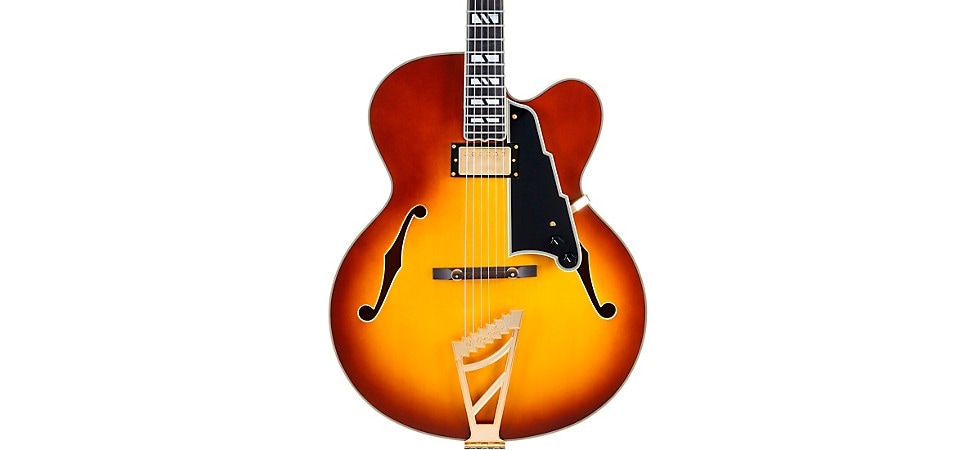
Shop Now: D'Angelico Excel EXL-1 Hollowbody Electric Guitar in Dark Iced Tea Burst
From the streets of New York to the hands of jazz royalty, D’Angelico guitars have been synonymous with archtop excellence since the 1930s. The D'Angelico Excel EXL-1 carries that tradition forward, blending vintage charm with evolved ergonomics, such as a slimmer, faster neck profile. A smooth-playing ebony fingerboard makes it effortless to navigate intricate voicings, offering a refined playing experience without sacrificing the classic D’Angelico character. Its fully hollow, 17" body sings with rich overtones, while the floating mini-humbucker keeps things clear and dynamic—perfect for warm, round comping or fluid, expressive solos. If your idea of tone leans toward Freddie Green’s chunky swing or the refined elegance of Johnny Smith, this is a guitar that speaks your language.
D'Angelico Premier SS
Why It Swings: Classic jazz box tone meets a more compact frame—perfect for players who want warm, expressive sound without the full-hollowbody bulk.
Things to Consider:
- Semi-hollow construction adds sustain and feedback resistance
- Duncan Designed humbuckers deliver smooth, articulate tones
- Stopbar tailpiece increases tuning stability and sustain

Shop Now: D'Angelico Premier SS Semi-Hollow Electric Guitar in Brown Burst
D’Angelico built its reputation on full-hollow archtops, but the Premier SS proves that great jazz tone doesn’t always require a big-body guitar. This semi-hollow model retains the warmth and resonance of its heritage while adding a touch more sustain and feedback resistance—ideal for players who mix traditional jazz phrasing with a more modern attack. The Duncan Designed humbuckers deliver smooth, articulate tones, and the stopbar tailpiece provides extra tuning stability, making this a jazz box that’s equally at home in smoky clubs or on concert stages.
Epiphone 150th Anniversary Zephyr DeLuxe Regent
Why It Swings: Like a warm desert wind, this golden-era archtop delivers the smooth, smoky resonance that defined jazz guitar’s earliest electric voices.
Things to Consider:
- Fully hollow, 17" body for deep resonance and acoustic warmth
- Single floating Epiphone NY Mini humbucker for pure, uncolored tone
- Stunning Art Deco-inspired appointments

Shop Now: Epiphone 150th Anniversary Zephyr DeLuxe Regent Hollowbody Electric Guitar in Aged Antique Natural
For almost a century, Epiphone’s jazz guitars have been legends, and the Epiphone Zephyr DeLuxe Regent is a worthy successor to the golden age of jazz archtops. This fully hollow, 17" beauty harkens back to the time when guitarists were just starting to carve out space in the band, and every note had to be played with intention. The floating NY Mini humbucker preserves the natural voice of the instrument, offering up the kind of warm, airy tone that players like Johnny Smith and Jim Hall built their legacies on. With an elegant spruce top, maple back and sides, and Deco-inspired details, the Zephyr isn’t just a guitar—it’s a time machine for those who crave that vintage archtop feel.
Epiphone Broadway
Why It Swings: Big, bold and built for the spotlight—this classic archtop is as at home in a dimly-lit club as it is under the bright lights of the Great White Way.
Things to Consider:
- Fully hollow, 17" body for rich, acoustic resonance
- Dual Alnico Classic humbuckers for warm, full-bodied tone
- Art Deco detailing and mother-of-pearl inlays for vintage flair
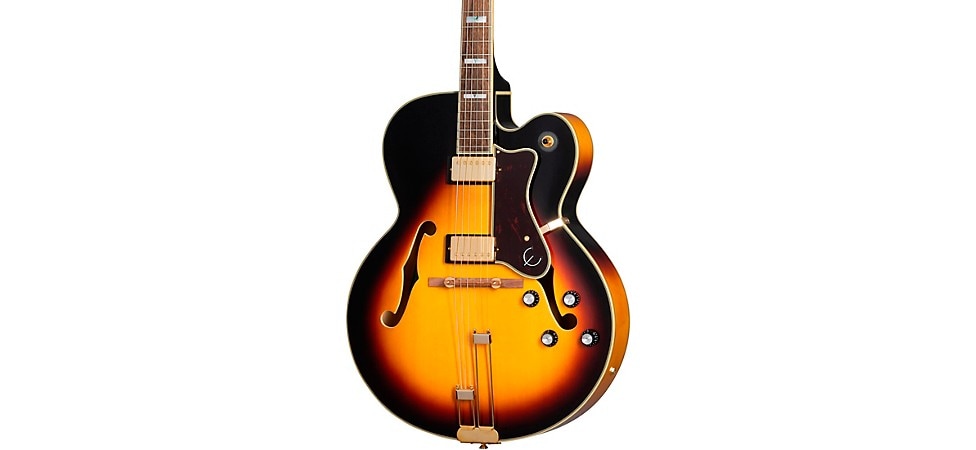
Shop Now: Epiphone Broadway Hollowbody Electric Guitar in Vintage Sunburst
First introduced in the 1930s, the Epiphone Broadway has been a staple of jazz guitar ever since, gracing the hands of players who want an archtop with both style and substance. With its 17", fully hollow body and dual Alnico Classic humbuckers, this guitar delivers a warm, articulate tone perfect for big band comping, chord-melody work or lyrical single-note runs. The floating rosewood bridge and trapeze tailpiece keep the sound open and resonant, while the beautifully appointed fingerboard and headstock reflect Epiphone’s golden-age aesthetics. From swinging through standards to stretching into contemporary voicings, the Broadway ensures every note takes center stage.
Epiphone Casino
Why It Swings: Lightweight, lively and always in the moment—this is a guitar that responds like a conversation, not a monologue.
Things to Consider:
- Fully hollow, thinline design for resonance and lightweight comfort
- Dual P-90 pickups deliver a warm, dynamic tone with bite
- Favored by rock legends but equally at home in a jazz setting
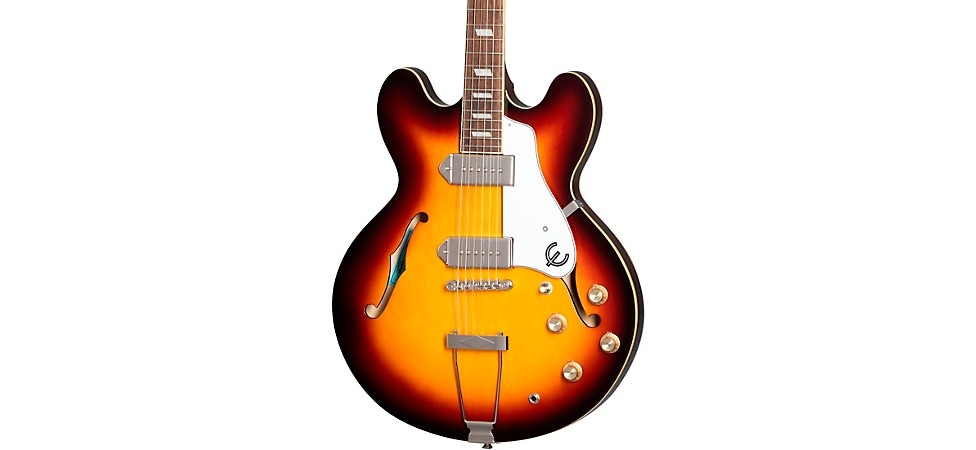
Shop Now: Epiphone Casino Hollowbody Electric Guitar in Vintage Sunburst
While you may know it from the Beatles, the Rolling Stones and Oasis—a trifecta of British rock royalty—the Epiphone Casino is also a great guitar for jazz. With its comfortable thinline, fully hollow construction, it delivers the warmth and resonance of a traditional archtop without the extra bulk. Closely related to the Gibson ES-330 but available at a more accessible price, the Casino shares much of its tonal DNA while offering its own distinct personality. The dual P-90 pickups bring a touch more articulation and bite than humbuckers, making it a great choice for jazz players who like their chords crisp and their single-note lines to sing, admittedly at the cost of a little hum when using higher gain. The lightweight build and lively acoustic response make it a joy to play whether you’re comping chord-melody arrangements or pushing into more exploratory territory. For those who like their jazz with a little edge, the Casino is ready to roll.
Fender Player II Telecaster
Why It Swings: The Swiss Army knife of jazz guitars—whether you’re chasing Ed Bickert’s warm, rounded comping or Julian Lage’s firebrand improvisation, the Telecaster delivers.
Things to Consider:
- Chambered ash body adds resonance and reduces weight
- Player Plus Noiseless pickups offer classic Tele clarity without hum
- Equally suited for fingerstyle chord-melody or hard-picking bebop runs
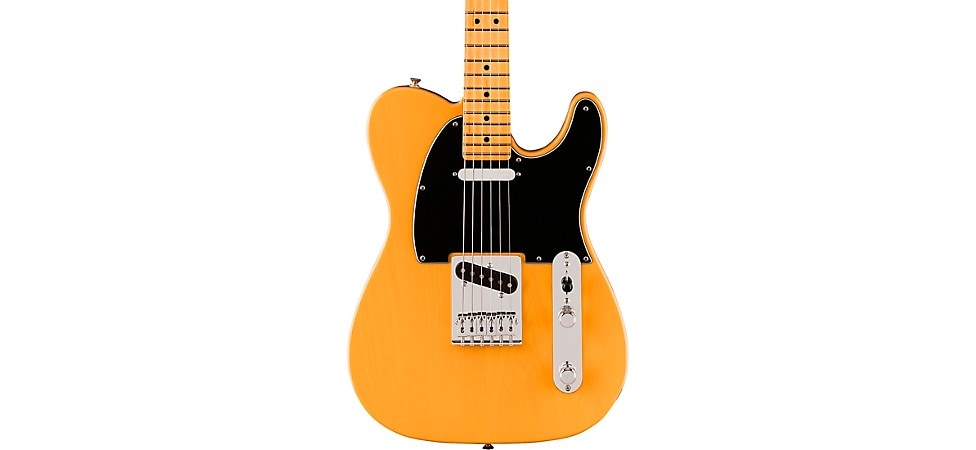
While the Telecaster may be better known for country twang and rock grit, in the right hands, it’s one of the most versatile jazz guitars out there. Ed Bickert’s warm, round chord voicings, Ted Greene’s deep harmonic explorations, and Julian Lage’s dynamic phrasing all prove that the Telecaster can swing with the best of them. The Fender Player II Telecaster model refines the formula with a chambered ash body for extra resonance and weight relief, while the Player Plus Noiseless pickups deliver all the Tele clarity and articulation without the single-coil hum. Whether you’re comping lush voicings, running bebop lines or stretching into the outer edges of jazz harmony, this Telecaster is ready to respond.
Gibson ES-335 '60s Block Limited Edition
Why It Swings: If the Tele is the Swiss Army knife of jazz guitars, the ES-335 ’60s Block limited edition is the Leatherman multi-tool—a little heavier, but just as versatile, with a tone that’s as smooth or as sharp as you need it to be.
Things to Consider:
- Semi-hollow construction balances warmth, sustain and feedback control
- Calibrated T-Type humbuckers deliver vintage-voiced clarity and depth
- Equally at home with traditional jazz, fusion and blues-inflected styles

Shop Now: Gibson ES-335 '60s Block Limited-Edition Semi-Hollow Electric Guitar in Sixties Cherry
The Gibson ES-335 '60s Block is a go-to for jazz players who want the warmth of an archtop without sacrificing sustain and articulation. Players like John Scofield, Lee Ritenour and Larry Carlton have all made the 335 their own, shaping everything from straight-ahead swing to genre-blurring fusion. The semi-hollow design offers rich resonance while resisting feedback better than a fully hollowbody, making it a natural choice for louder stage environments. The pickups deliver a balanced tone—warm enough for smooth comping, but with enough bite to cut through a mix when the moment calls for it. So, if you like your jazz clean and classic or with a little more edge, the ES-335 is always up for the job.
Gibson ES-330
Why It Swings: The hollowbody that walks the line between refinement and grit—this is the guitar of choice for players who want warmth, resonance and just a little bit of an edge.
Things to Consider:
- Fully hollow body for rich acoustic-like resonance
- Dual P-90 pickups offer warmth, clarity and dynamic sensitivity
- Lighter and more resonant than the ES-335, but with a similar feel

Shop Now: Gibson ES-330 Hollowbody Electric Guitar in Tobacco Sunburst
The Gibson ES-330 might not be as famous as its semi-hollow cousin, but for those in the know, it’s a jazz guitar with a voice all its own. Emily Remler wielded one to stunning effect, combining smooth bebop lines with fiery phrasing that could push beyond the boundaries of traditional jazz. With its fully hollow construction, the ES-330 has a natural resonance that responds beautifully to a light touch but can also growl when pushed. Though it shares its design heritage with the Epiphone Casino, the ES-330 offers the premium Gibson treatment—from materials to craftsmanship. The P-90s deliver a blend of warmth and articulation, making them perfect for chord-melody arrangements, nimble single-note runs or even more modern, angular playing. If you want a guitar that breathes with you, the ES-330 is one to consider.
Ibanez LGB30 George Benson Signature
Why It Swings: Smooth, precise and effortlessly stylish—this is a jazz guitar built to meet the demands of one of the genre’s most fluid and expressive players.
Things to Consider:
- Hollow spruce/maple body for balanced warmth and articulation
- Super 58 Custom humbuckers deliver rich, responsive tone
- Elegant appointments, including an ebony fingerboard and GB-style tailpiece
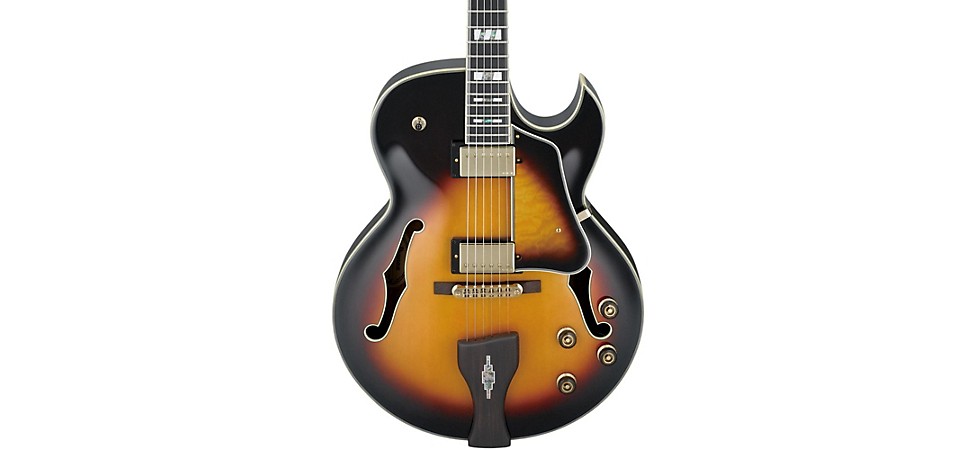
Shop Now: Ibanez LGB30 George Benson Signature Hollowbody Electric Guitar in Vintage Yellow Sunburst
When George Benson made the switch to Ibanez in the late ’70s, it wasn’t just a change in branding—it was a declaration that jazz guitars could be refined for modern playing without sacrificing their classic soul. The Ibanez LGB30 George Benson Signature is built to Benson’s specs, offering a buttery-smooth playing experience that suits everything from rapid-fire bebop runs to his signature fluid phrasing. The spruce and maple body provides warmth without muddiness, while the Super 58 Custom humbuckers deliver the kind of clarity and responsiveness that let every note breathe. It doesn't matter if you’re comping chord melodies or taking the lead with singing, horn-like lines—this guitar will swing as effortlessly as the player who inspired it.
Yamaha SA2200
Why It Swings: Refined, responsive and endlessly versatile—this semi-hollow is proof that Yamaha knows its way around a jazz guitar.
Things to Consider:
- Semi-hollow sycamore body for balanced warmth and sustain
- Alnico V humbuckers with coil splitting for tonal flexibility
- Impeccable Japanese craftsmanship and premium appointments

Shop Now: Yamaha SA2200 Semi-Hollow Electric Guitar in Brown
The Yamaha SA2200 might not have the same name recognition as some of its semi-hollow competitors, but those who’ve played one know it’s one of the best-kept secrets in jazz guitars. Built with the kind of precision Yamaha is known for, the SA2200 delivers a beautifully balanced tone—warm enough for rich comping but articulate enough to handle intricate single-note lines with ease. The Alnico V humbuckers offer smooth, classic jazz tones and with coil splitting onboard, this guitar can also step outside the traditional jazz sound when needed. No matter what you’re doing—backing a vocalist, leading a trio or taking harmonic conceptions to the next level—the SA2200 is an instrument that rises to the occasion.
Back to the Head
Now that we've given each of these guitars a couple of featured choruses, you should have a solid sense of what makes them great for jazz and which ones might suit your style—and budget—best. Jazz guitar is a big tent, encompassing everything from the bebop fluency of Bruce Forman to contemporary players like Peter Bernstein and Mary Halvorson, and avant-garde innovators like James Blood Ulmer and Bill Frisell—all of whom are well worth exploring if you're not already familiar with their work.
Finding the right guitar is a deeply personal voyage and, as always, the best way to get a feel for a particular guitar is to try it out for yourself. So, stop by your local Guitar Center to get hands-on with the ones that interest you most, and don't hesitate to tap one of our knowledgeable sales associates for guidance. Or, if you prefer, give a call to your personal Gear Adviser and chat about what's right for your fingers.
In the meantime, you might also want to check out some relevant articles here on Riffs, like our comparison of humbuckers vs. single-coils or our look at recording techniques for electric guitar. And, of course, practice. Every new skill you pick up along the way opens doors—and ears—to new sounds and new possibilities.

Pictured: D'Angelico Excel EXL-1 and Yamaha SA2200
People Also Ask ...
Does the body type of a guitar affect its jazz tone?
Absolutely. Archtop guitars, with their hollow bodies and f-holes, are traditionally favored in jazz for their warm, resonant tones. However, many jazz musicians also embrace semi-hollow and solid-body guitars for their unique tonal qualities and versatility. Ultimately, the best choice depends on your personal sound preferences and playing style.
Are specific pickups better suited for jazz?
Yes, pickups play a significant role in shaping your tone. Humbuckers are popular among jazz guitarists for their warm, full-bodied sound and reduced noise. P-90 pickups, known for their clarity and brightness, are also favored by some players seeking a more articulate tone. Your choice should align with the specific jazz sound you’re aiming for.
Do I need an expensive guitar to play jazz?
Not necessarily. While high-end guitars often offer superior craftsmanship and materials, many affordable models deliver excellent jazz tones, especially when paired with quality amplification and proper setup. It’s important to find a guitar that feels comfortable and inspires you to play, regardless of its price tag.
Can I play jazz on a solid-body guitar?
Certainly. While hollow and semi-hollow guitars are traditional in jazz, solid-body guitars like the Fender Telecaster have been effectively used by jazz musicians. The key lies in your technique, amp settings and overall approach to achieving the desired jazz tone.
How important is the neck profile for jazz playing?
The neck profile significantly impacts playability. Jazz guitarists often prefer necks that facilitate complex chord voicings and smooth single-note runs. However, the ideal neck shape is subjective and varies among players. It’s advisable to try different profiles to discover what feels most comfortable for your hand and playing style.





